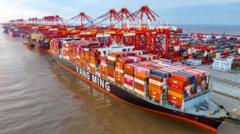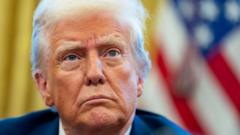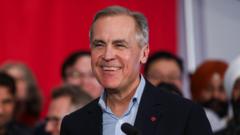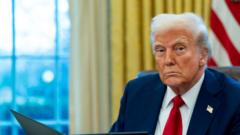With Trump resuming power, concerns arise over potential new tariffs that could disrupt international trade relationships and impact inflation rates globally, particularly affecting the US, China, Canada, and Mexico.
"Trump 2.0: Tariffs and the Impact on Global Economy in 2025"

"Trump 2.0: Tariffs and the Impact on Global Economy in 2025"
As Donald Trump returns to the political arena, his potential trade policies could reshape the global economic landscape, influencing inflation and growth predictions.
The anticipation of "Trump 2.0" looms large as the global economy braces for a complex 2025, with expected growth remaining steady but lackluster at 3.2%, according to the International Monetary Fund. As the year approaches, the Federal Reserve's cautious stance on interest rate cuts in a battle against inflation brings mixed signals to financial markets. Although November saw inflation rates tick up in the US (2.7%), eurozone (2.2%), and UK (2.6%), the overarching challenge for central banks is navigating the uncertainty tied to Trump's trade policies.
Luis Oganes of JP Morgan highlights that Trump’s potential to reintroduce tariffs may benefit short-term US growth but would certainly harm economies reliant on US trade. This shift towards protectionism could particularly be destabilizing for Mexico and Canada, where trade interdependence could exacerbate the fallout on supply chains, especially in key sectors like auto manufacturing. Maurice Obstfeld, former chief economist at the IMF, cautions that these tariffs could send shockwaves through global markets, even pushing economies toward recession.
China, the world's second-largest economy, also faces its own challenges amidst threats of renewed tariffs. President Xi Jinping has signaled optimism for an upward economic trajectory, with the World Bank increasing China's growth forecast to 4.5% for 2025. However, ongoing tensions with the US and changes in trade policy could hinder this recovery, especially as tariffs may decrease demand for Chinese exports—an essential component of its economy.
The effects of potential tariffs extend to Europe, where concerns about increased inflation arise. European Central Bank president Christine Lagarde asserts that protectionist measures inherently threaten economic growth. Meanwhile, economic performances in Germany and France have been volatile, underscoring the need for increased consumer spending to maintain momentum in the eurozone.
As economic forecasts suggest continued resilience in the US and escalating tariffs could change the landscape of global trade, companies contemplate relocating supply chains. Nonetheless, experts like Michael Hart of the American Chamber of Commerce in China caution that replacing China's manufacturing capabilities is no easy feat after decades of market establishment.
Looking ahead, Trump's policy focus on tax cuts and deregulatory measures may position the US economy favorably, but economists warn that successful management of inflation will hinge on the White House's trade stratagems. With the global economic stage set for a tumultuous year, the ramifications of Trump’s strategies will have a lasting impact beyond borders.






















